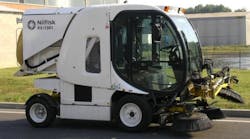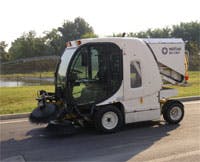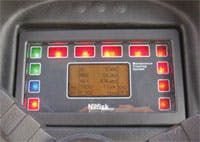Hydraulics is great for generating high force or high torque from within a small package. Because of this, hydraulic cylinders and motors are widely used in just about every type of mobile equipment. Another big advantage of hydraulics is speed control. By varying the flow to a motor, motor displacement, or both, a wide range of speeds can be achieved in forward or reverse directions.
Yet, with all this versatility, hydraulic motors often are relegated to driving a gearbox. Sometimes this is done to allow using a smaller motor. Because a smaller motor costs less, it helps offset the additional cost of the gearbox. Moreover, the gearbox often is a planetary gear drive integral to a wheel drive. The wheel drive contains the bearings and other hardware necessary to drive the vehicle’s wheels directly.
With the smaller motor operating at higher speed, the gearbox acts as a speed reducer and torque multiplier. Many motor designs operate at highest efficiency at speeds too high to drive vehicle wheels directly. Even though it adds cost and complexity to the drive, the gearbox maintains high efficiency of the drive, which is becoming an increasing important selling point for equipment manufacturers.
Another benefit to using an auxiliary gearbox is to prevent cogging. Although most motor designs operate most efficiently at moderate speeds, they can operate at low speeds. The problem is, they may produce rotational pulsations at lower speeds — often referred to as torque ripple or cogging. Under load, the motor may rotate at a nominal speed of, say, 30 rpm. However, instantaneous speed may vary from 27 to 33 rpm. If the motor contains, say, six pressure chambers, its instantaneous speed may slow to 27 rpm, then speed up to 33 rpm six times per revolution.
The speed reducer helps reduce the effect of cogging by increasing the frequency of pulsations. For example, if a motor generates six pulse per revolution, and the gearbox reduces speed by three to one, then 18 pulsations per revolution will be transmitted to the wheel. This higher frequency of pulsations has the effect of making them less noticeable. Therefore, allowing the motor to operate at a higher speed can reduce the cogging effect.
A simpler approach
On the other hand, many designers prefer a simpler approach by using a hydraulic motor that operates at the required speed — thereby eliminating the need for a gearbox. This approach can save money, installation time, provide a more compact design, and reduce vehicle weight. However, the motor must be able to deliver the required torque at the required speed, and without serious cogging.
The severity of cogging depends on the particular design of motor. Even though two motors may share the same basic design — such as axial piston or radial piston — they may exhibit quite different dynamics. Therefore, it is important to investigate the dynamic behavior of motors within the parameters of an application — not just pressure, torque, and speed capabilities.
Putting knowledge to practice
Choosing a motor to drive their RS1301 sweeper was a challenge presented to engineers at Nilfisk Advance Group, a manufacturer of sweepers, vacuums, and other cleaning equipment based in Guardamiglio, Italy. Nilfisk engineers could have chosen just about any type of motor for the sweeper, but they recognized that efficiency is becoming an increasingly important consideration among their customers, so they decided to specify a motor design that would operate efficiently and run smoothly, without cogging, even at low speed. The engineers chose to drive the front wheels of the sweeper with a pair of radial-piston motors — a design noted for its lowspeed, high-torque performance.
The RS 1301 is powered by a 67- kW diesel engine and can achieve a speed of 23 km/hr. Nilfisk engineers chose Model 250-P2G motors from SAI Spa Hydraulic Motors, Modena, Italy. The motors have a displacement of 251 cc/rev, a torque rating of 3.92 N-m/bar, peak pressure rating of 425 bar, maximum speed of 800 rpm, and maximum power rating of 59 kW. This provides more than enough muscle to scale a 24% grade.
Additional features
The motors feature SAI’s F32 brake, which can used for dynamic braking. They also have a yoke that accepts a mechanical pull cable for a parking and emergency brake function.
A useful option of the P2G series motors is an inductive proximity sensor that generates a multiple of five pulses for every revolution of the motor. Because the diameter of the sweeper’s front tires is known, the frequency of pulses can be differentiated over time to calculate vehicle speed.
The sweeper’s main control performs this calculation. It also monitors vital hydraulic and engine functions and keeps track of maintenance schedules to alert the drive when, for example, hydraulic filters must be changed. The control also executes safety interlocks to prevent opening access panels while the machine is running.
For more information on SAI’s hydraulic motors and other products, call (610) 497-0190, e-mail [email protected], or visit www.saihyd.com.
|
Understanding volumetric efficiency An important specification for any type of power transmission is, or course, efficiency. With hydraulic systems, both mechanical and volumetric efficiencies come into play. Mechanical efficiency refers to frictional losses to operate the motor, whereas volumetric efficiency refers to the amount of fluid that leaks internally from high-pressure areas within the motor to low-pressure areas without producing useful work. For example, if a motor’s displacement is equal to 18-gal per revolution, and 6 gpm flows to the motor, theoretically, it should rotate at 48 rpm. In actuality, it will rotate at a slower speed because some fluid will enter the pump, leak between the clearances within the pump, and exit the pump without performing any work. This internal leakage generally increases as the load (pressure) increases. However, George H. Morgan, P.E., a registered patent agent and hydraulic consultant, explains that at a given pressure, leakage for a specific motor remains relatively constant, independent of speed. So for the example just cited, if the motor rotates at 48 rpm, volumetric efficiency would be 100%. If the motor rotates at a more realistic 44 rpm, volumetric efficiency would be 91.67% — with 112 of the fluid (0.5 gpm) lost to internal leakage. But if flow to the motor is reduced to, say, 3 gpm, the leakage would remain at roughly 0.5 gpm. So with half the total flow, but a constant leakage of 0.5 gpm, volumetric efficiency would now be 83.3%. Morgan says this volumetric inefficiency can be a major contributor to cogging at low speeds. What this all means is that a motor will probably be consistent with published efficiencies when operating at published pressures and speeds. But if you expect the motor to run at lower speeds, expect overall efficiency to drop. How much depends on the design of the motor, quality of construction, and similar variables. So when specifying a motor for an application, ask the supplier for performance specifications that correspond to the speeds and loads you expect to encounter. |



